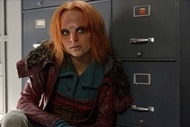Create a free profile to get unlimited access to exclusive videos, sweepstakes, and more!
Is Rapunzel's hair just fairy-tale magic, or could hair really grow that long and strong?

Disney’s Tangled hit theaters 10 years ago this week. Continuing the House of Mouse’s long tradition of popular fairy-tale adaptations, Tangled, directed by Nathan Greno and Byron Howard, tells an updated interpretation of the Rapunzel tale.
The story of Rapunzel has uncertain origins, but we do know it was eventually collected by the Brothers Grimm, cementing its position within the pantheon of classic stories. Disney’s rendition adds its own elements, namely that of a magical quality to Rapunzel’s hair. And, of course, songs.
One wonders, though, if there isn’t some truth to this yarn. We'll aim to find out if Rapunzel's hair could really grow that long or be strong enough to support the weight of a dashing young suitor.
HOW LONG CAN HUMAN HAIR GROW?
In order to answer this question, we must first understand how hair grows. Your hair goes through three distinct cycles beginning with anagen and ending with telogen.
In the anagen phase, your hair is growing. This is the most common phase and about 90 percent of your hairs are in this phase at any given time. During this time, new hairs grow in the follicle, breach the surface, and grow. The rate at which they grow, and for how long, depends on a number of factors including chemical signals and the location of the hair on the body. Those factors are the reason the hair on your head can grow so long, while the hair on your body is more limited.
In the next phase, known as catagen, the follicle shrinks and hair growth stops. The hair then separates from the follicle but remains in place. At any given time, about 5 percent of your hairs are in this phase. This is sort of the last gasp of an individual hair. If it had any bucket list items to cross off, this would be the time to do it.
Finally, the hair enters telogen, the resting phase. With the hair disconnected and no longer growing, your follicle has a chance to take a breather and prepare for a new hair to take root. The old hair will fall out, probably landing in your mouth or in someone’s soup, and the cycle starts all over again.
For scalp hair, the rate of growth is approximately half an inch per month and the anagen phase lasts an average of three years. For these reasons, the average maximum length of human hair is roughly three feet. No matter how long you go without a haircut, your own biological processes conspire against your hair getting any longer — though there are some notable exceptions.
HAIR ROPE?
Presuming you’re one of the genetically lucky (or unlucky) few, with hair that never quits growing, you might end up with a set of locks capable of lowering to the ground from atop a lofty tower. You might then find yourself at the beck and call of a witch or a gallant prince in need of a lift.
A single human hair is capable of holding up to 100 grams. That’s more than half the weight of the average smartphone (chosen because it’s probably the most common object you regularly hold in your hand). Still, the average European male (chosen because that’s the most common type Rapunzel might have encountered) weighs about 160 pounds.
The tensile strength of a single human hair, while impressive, could hold only about one-tenth of a percent of that weight.
Luckily, the average head has about 100,000 hairs and their combined strength is more than enough to carry the weight of a person. It’s estimated that a full head of healthy hair could hold thousands of pounds, but we know it is at least strong enough to hold the weight of a person. For proof, we need only to look at circus acts for proof.
Danila Bim is a performer for Cirque du Soleil, performing the Hair Hang. According to Bim, it took months for her to train herself to be able to support her own weight with only her hair. Now, using only a metal ring, a rope, and peak physical fitness, she’s able to support her weight even dozens of feet in the air.
The feat is impressive, if a little terrifying, and shows the impressive strength of human hair. The real marker here is the ability of the scalp to endure the pressure. The hair itself has no nerve endings and feels no pain, so if ever you’re in a situation where you need to lift yourself or someone else by your hair, we’d recommend you anchor it to something else and take the pressure off your scalp.
Also, obviously, don’t try this at home.
WHY DOES OUR HAIR GROW SO LONG, ANYWAY?
Humans' hair growth appears seemingly unique in the animal kingdom. Hair, in and of itself, is not special. Mammals of all stripes have hair, more commonly called fur for the non-humans, but it acts in essentially the same ways.
Looking even at different breeds of the same animals, like cats or dogs, we see that some of them have fur that remains eternally short, while others have something akin to our flowing, luscious locks.
There are a number of hypotheses about why we lost most of our fur during the evolutionary process. It might have been that losing fur on the face allowed us to better read one another’s emotional cues. Another idea is that endurance hunting during the heat of the day, particularly in sub-Saharan Africa, necessitated a greater ability to sweat, which is better facilitated by having less hair.
It’s a question still in need of a definitive answer, but, for whatever reason, we maintained our thicker scalp fur even while the rest of it receded. It’s probably that scalp fur remained as a sort of protection from the Sun.
We need direct contact with sunlight in order to produce vitamin D. But too much contact can have ill effects, as evidenced by anyone who’s ever suffered a particularly painful sunburn. Hair atop the head helps prevent that. It’s also why you might have an uncle with particularly hairy shoulders or a furry back.
There’s not a clear answer on why our head hair grows so long while the same isn’t seen in other animals. It could be there’s some evolutionary advantage putting pressure on longer hair. Or it may be an artifact. Evolution, after all, doesn’t necessarily care about the objective best, so much as it cares about the good enough.
What we do know is the same processes are present in humans as in other mammals. Each follicle goes through those same three stages. It just so happens that the fur on your head has a longer anagen phase than your non-human counterparts.
A biological happenstance that benefits both hairstylists and imprisoned princesses alike.


























